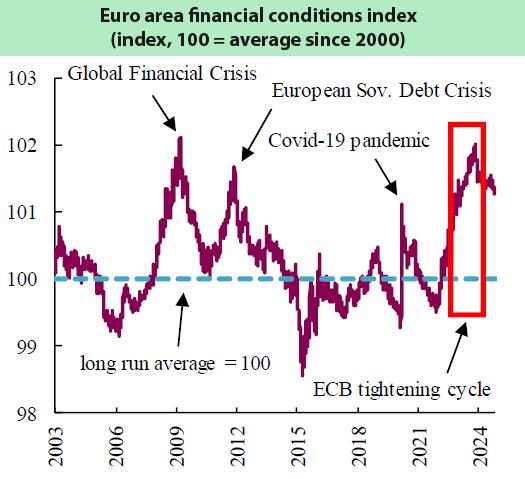
QNB Group Expects ECB To Cut Interest Rates By 150 Base Points By Mid-2025
Doha, Qatar: In mid-2022, an unprecedented inflationary surge pressed the European Central Bank (ECB) to embark on its most aggressive monetary tightening cycle to date. In less than a year and a half, a record sequence of ten consecutive rate hikes took the benchmark deposit rate to 4%, its highest historical point. Supply chain normalization and tight monetary policy succeeded in curbing inflation, bringing it down from its peak of 10.6%, to below the 2% target of the central bank, QNB said in its economic commentary.
With inflation under control, the ECB began the new phase of interest rate cuts in June this year, taking the benchmark deposit rate to 3.25%. Going forward, the ECB needs to cautiously calibrate the path of interest rates, as the balance of risks gives more weight to economic stagnation than to inflation concerns. Leading economic indicators, which refer to statistics that anticipate economic conditions, have underperformed relative to forecasts in recent quarters.
The Economic Surprise Index provides a formal measure of how data releases stand relative to expectations. During the first half of 2024, the index was pointing to a significant improvement in conditions. This recovery injected a moderate dose of optimism into the economic outlook. However, this optimism proved to be short-lived as the European bloc was unable to unshackle itself from the negative spiral shaped by stringent monetary conditions, weak external demand, geopolitical uncertainty, and the energy crisis. In our view, the current context will lead to a more aggressive monetary easing cycle than what is currently expected by the markets. In this article, we discuss the three main factors that support our views.
First, with prices already under control, there is now an increasing risk that inflation drops too far below the objective of the ECB. Furthermore, a deflation spiral is now becoming a conceivable, even if still not highly likely, threat on the horizon. A deflation environment is deeply detrimental to the economy, as households and firms delay expenditures and investment to benefit from lower prices in the future, generating a negative economic feedback loop.
Second, financial conditions remain highly restrictive on the back of still-elevated interest rates and the steady retrenchment of the central bank balance sheet. The current deposit facility interest rate of 3.25% still implies a restrictive level for the real interest rate, which adjusts the cost of credit according to inflation. Similarly, although overall financial conditions have come down since their peak restrictive heights in October last year, they remain at levels previously seen only during the Global Financial Crisis and the European Sovereign Debt Crisis. Furthermore, the ECB continues to revert the balance sheet expansion that was put in place during the pandemic, which is limiting the availability of credit.
Lower liquidity and higher credit costs have an impact on the volumes of credit, which are contracting in real terms, signalling to the ECB that monetary conditions are excessively restrictive.
Third, the Euro Area has remained on the verge of a recession during the last couple of years, and its economic growth performance is expected to remain lacklustre. The most recent prints of the Purchasing Managers Index (PMI) signal a stagnant economic outlook.
The PMI is a survey-based indicator that provides a measurement of improvement or deterioration in the economic outlook. The composite PMI, which tracks the joint evolution of the services and manufacturing sectors, has remained below or close to the 50-point threshold that separates contraction and expansion. Additionally, despite the resilence of labor markets, the number of job openings is pointing to softening job creation, while real GDP growth in 2024 and 2025 is expected to remain below the long-term average of 1.4%. Hence, weak economic growth is another factor in favour of faster interest rate cuts by the ECB.
All in all, the downside risks to economic growth in a context of low inflation, restrictive monetary conditions and stagnant activity will press the ECB to cut interest rates by 150 bp by mid-2025, taking the benchmark deposit rate to 1.75%.

Legal Disclaimer:
MENAFN provides the
information “as is” without warranty of any kind. We do not accept
any responsibility or liability for the accuracy, content, images,
videos, licenses, completeness, legality, or reliability of the information
contained in this article. If you have any complaints or copyright
issues related to this article, kindly contact the provider above.


















Comments
No comment